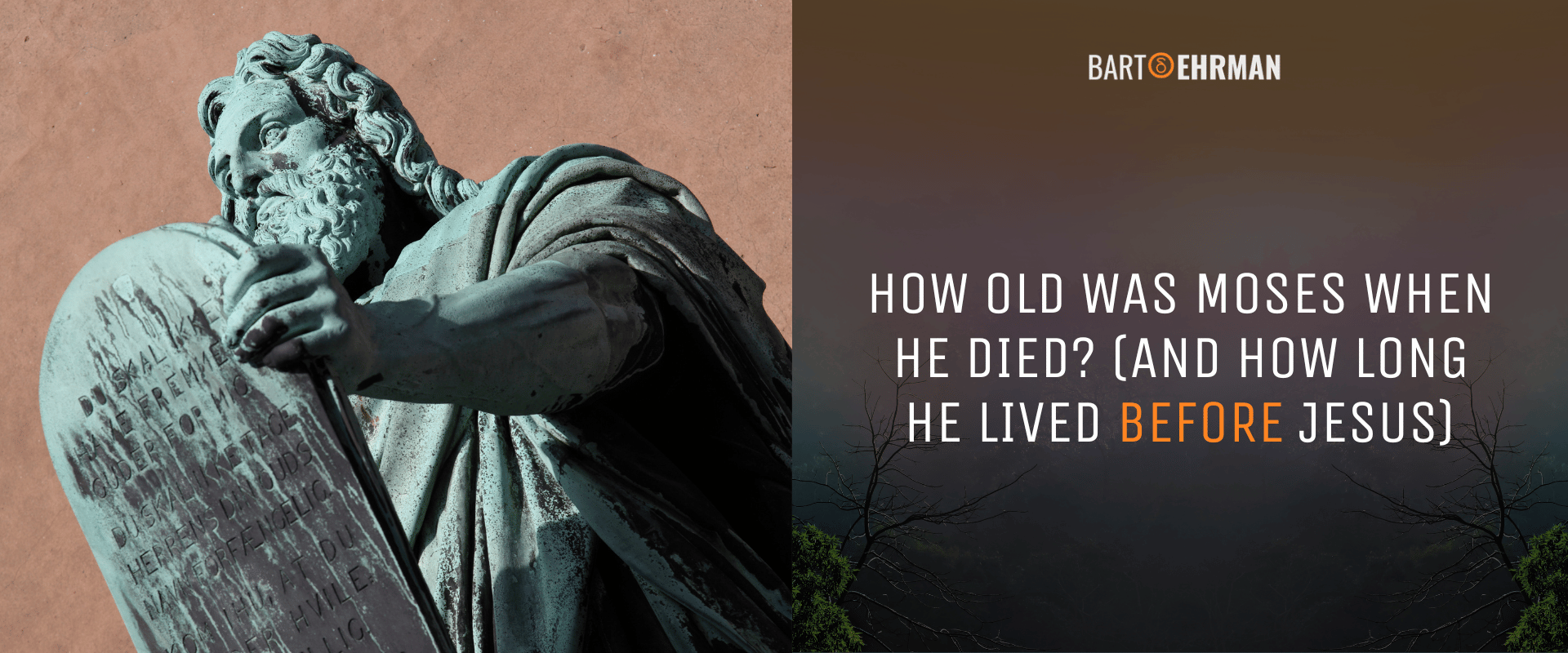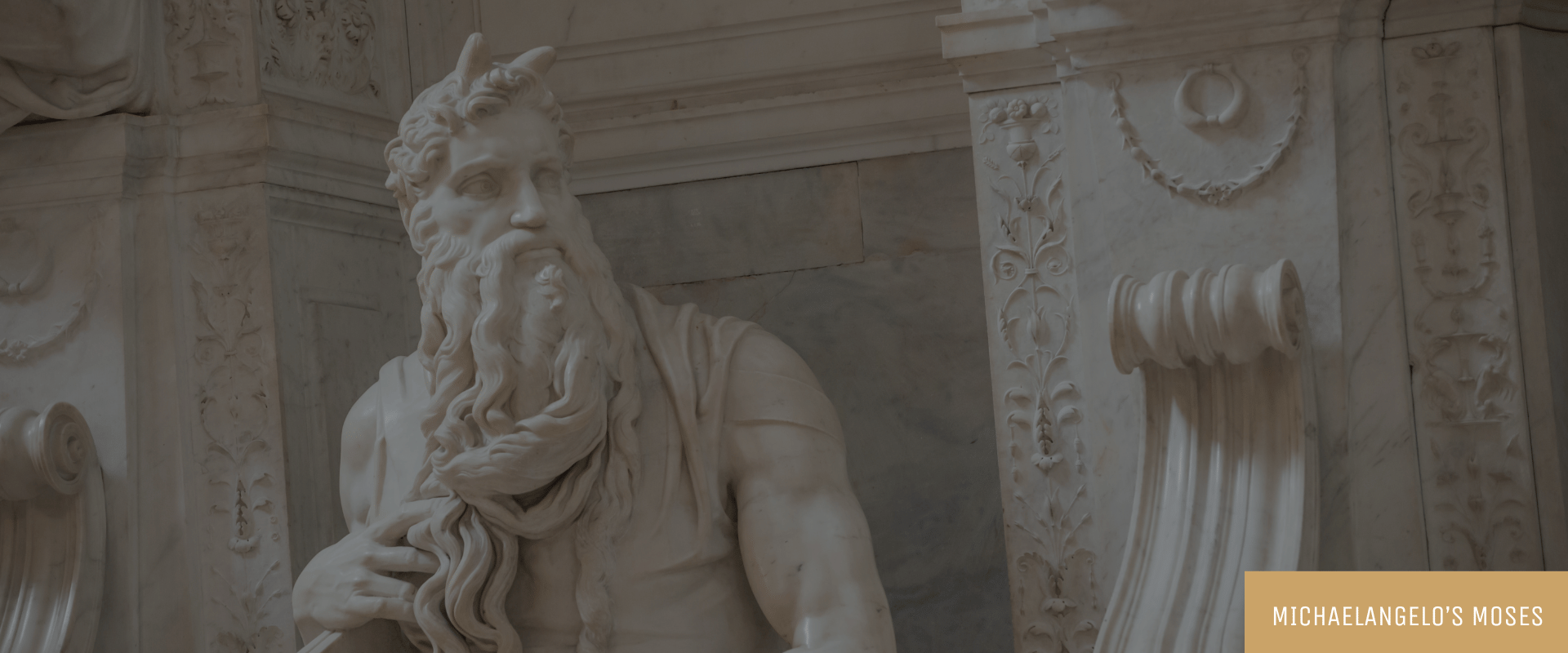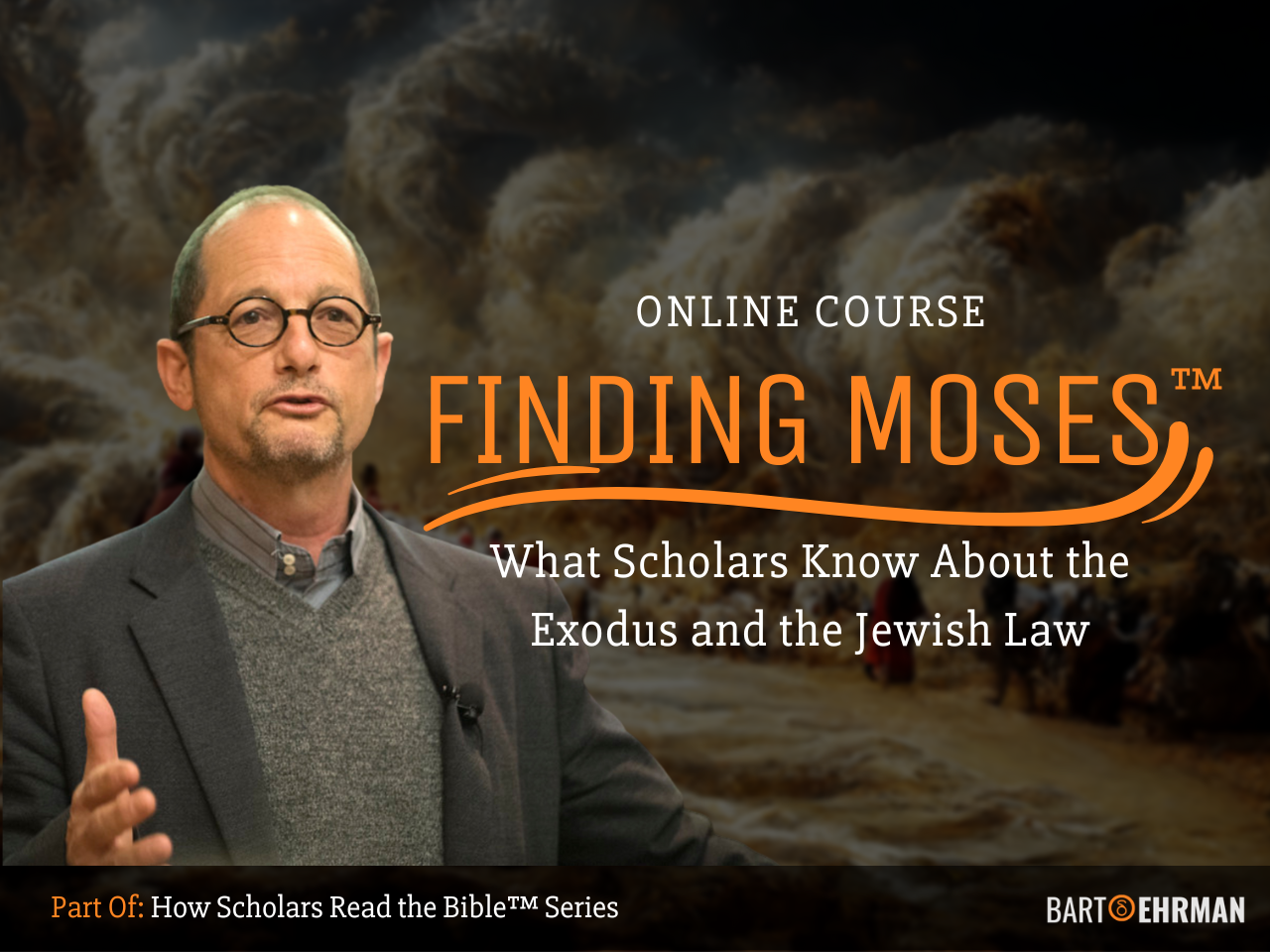How Old Was Moses When He Died? (And How Long He Lived Before Jesus)

Written by Marko Marina, Ph.D.
Author | Historian
Author | Historian | BE Contributor
Verified! See our guidelines
Verified! See our editorial guidelines
Date written: February 12th, 2025
Disclaimer: The views and opinions expressed in this article belong to the author and do not necessarily match my own. - Dr. Bart D. Ehrman
How old was Moses when he died? This question has fascinated scholars, theologians, and believers for hundreds of years. The Biblical narrative presents Moses as a towering figure. He led the Israelites out of Egypt, received the Ten Commandments, and guided his people through the wilderness. But beyond his legendary status, when did Moses live, and how long was his life according to tradition?
Recently, I’ve been reading the letters and speeches of Martin Luther King Jr., and it’s striking to see how biblical themes (especially those from the Old Testament) shaped his public ministry. Few figures influenced him more than Moses.
In his Nobel Prize acceptance speech in 1964, for instance, King reflected on the Exodus story, declaring: “The yearning for freedom eventually manifests itself. The Bible tells the thrilling story of how Moses stood in Pharaoh's court centuries ago and cried, ‘Let my people go.’ This is a kind of opening chapter in a continuing story.”
So, it would be a mistake to think of Moses as belonging solely to the distant past. His image is deeply carved into the collective memory of Western civilization. From religious traditions to literature, art to political movements, Moses continues to inspire.
Given his enduring significance, it’s worth looking back at the biblical narrative and focusing on his timeline, asking key questions: When did Moses live? How old was Moses when he died?
Before we begin, it’s important to clarify that this article won’t address the question of whether Moses was a historical figure. That is a complex issue best saved for another discussion. Instead, this article follows the biblical and traditional accounts, presenting Moses’ life as recorded in scripture without affirming or denying its historical accuracy.
With that framework in mind, let’s explore what the Bible tells us about Moses’ lifespan and his place in history. But before that, I have an important announcement!
If you're fascinated by how biblical narratives blend history, legend, and myth, you might enjoy Dr. Bart D. Ehrman’s online course, In the Beginning: History, Legend, or Myth in Genesis?
In six engaging 30-minute lessons, Dr. Ehrman examines the Book of Genesis from a scholarly perspective, distinguishing myth from historical reality and exploring famous stories like Noah’s flood and the seven-day creation. Check it out to deepen your understanding of how ancient traditions shaped Biblical accounts!

Moses’ Life: A Biblical Timeline
In Commentary on Exodus, Carol Meyers offers a striking assessment of Moses’ unparalleled significance in the biblical tradition:
(Affiliate Disclaimer: We may earn commissions on products you purchase through this page at no additional cost to you. Thank you for supporting our site!)
An overview of Moses' prominence is instructive. Beginning with his dramatic birth story, Moses is the most important human figure in the unfolding story of the Israelites, from oppression in Egypt to witnessing God's presence at Sinai... Yet, despite the humanity portrayed in these family relationships, he transcends ordinary humanity in the astonishing variety of his roles and success, often despite the resistance of friend and enemy alike, with which he exercises leadership in all areas of national life. It is not an understatement to call him super-human. Moses is a larger-than-life figure, if not a demi-god.
Given his immense significance, it is only fitting that we take a step back and lay out his life in a structured timeline.
Before we explore the broader historical context or compare Moses to other key biblical figures, though, we should first map out his journey from birth to death. After all, how old was Moses when he died? And at what stages did the pivotal moments of his life take place?
To answer these questions, we’ve put together a timeline summarizing his key life events, including his approximate age at each milestone and traditional dating estimates. We’re quite proud of this, and you should be too! After all, let’s be honest, who doesn’t love a well-organized table?
Age | Approximate Year (Early Dating) | Approximate Year (Late Dating) | Event |
|---|---|---|---|
0 | C. 1526 B.C.E. | C. 1391 B.C.E. | Birth in Egypt; Placed in a basket in the Nile. |
40 | C. 1486 B.C.E. | C. 1351 B.C.E. | Kills an Egyptian, and flees to Midian. |
80 | C. 1446 B.C.E. | C. 1311 B.C.E. | Returns to Egypt; Leads the Exodus. |
120 | C. 1406 B.C.E. | C. 1271 B.C.E. | Dies at Mount Nebo before entering the Promised Land. |
When Did Moses Live? The Broader Historical Context
The biblical story of Moses, as described in Exodus, begins with a dramatic escape from death. According to the narrative, Pharaoh, fearing the growing population of the Israelites in Egypt, decreed that all newborn Hebrew boys should be cast into the Nile (1:22).
To save him, Moses’ mother placed him in a basket and set him on the river. There, Pharaoh’s daughter discovered and raised him. This act of divine providence set the stage for Moses' eventual role as the leader of the Israelite people. But when exactly did Moses live? What was the historical context of the time?
Dating Moses' life has long been a topic of debate, but many scholars associate his story with the reign of Ramses II, one of ancient Egypt's most powerful pharaohs. As Jonathan Kirsch notes in his Biography of Moses:
The pharaoh who enslaved the Israelites was dubbed Meror, ‘the Bitter One,’ in the folklore of the Jewish people, but the favorite candidate among scholars and theologians is the celebrated Ramses II, who reigned from circa 1279-1213 B.C.E.
This identification is based largely on the biblical reference to the city of “Pi-Ramesses” (Exodus 1:11), which was built during Ramses’ reign and may have been connected to the Israelites' labor. If Moses lived during this time, he would have been born in the 14th or 13th century B.C.E. which would place his leadership of the Exodus in the late 13th century B.C.E.
Ramses II's reign was characterized by military campaigns, massive construction projects, and a heyday of Egyptian power.
Often called “Ramses the Great,” he ruled for an astonishing 66 years, during which he expanded Egypt’s borders, fought major battles such as the Battle of Kadesh against the Hittites, and commissioned grand architectural projects, including the temples at Abu Simbel.
In his book Who’s Who in Ancient Egypt, Michael Rice provides a fair summary of Ramses’ life and reign:
Ramesses is chiefly recalled for his frenetic building programs, covering the land of Egypt with gigantic structures, most of them containing huge representations of himself. He married many times, though his favorite wife seems to have been NEFERTARI, who has a small and elegant temple next to his huge one at Abu Simbel. He was the father of many children (he was said to have produced over one hundred) of whom Prince KHAEMWASET was perhaps the most notable.
Egypt was, therefore, a dominant force in the Near East at this time, exerting influence over Canaan and its surrounding regions.
Beyond Egypt, the broader Near Eastern world was a dynamic and evolving cultural landscape. Canaan, where Moses was said to have led the Israelites, was inhabited by a mix of peoples, including Canaanites, Amorites, and early Israelite groups.
Religious practices in the region varied, but they often centered on polytheistic traditions, with deities like Baal, Asherah, and El playing significant roles. As scholar Mark S. Smith explains in his book The Origins of Biblical Monotheism, early Israelite religion likely emerged within this diverse environment, gradually differentiating itself through the exclusive worship of Yahweh.
But how old was Moses when he died? According to Biblical tradition, Moses lived to be 120 years old (Deuteronomy 34:7). His death, as recorded in Deuteronomy, took place on Mount Nebo, where he was granted a vision of the Promised Land but not permitted to enter it.
How long did Moses live in the Bible? His life is traditionally divided into three distinct 40-year periods: 40 years in Egypt, 40 years in Midian after fleeing Pharaoh, and 40 years leading the Israelites through the wilderness.
With this in mind, we now turn to the question of how Moses' timeline fits within the broader biblical narrative, particularly in relation to figures like Abraham, David, and Jesus.
Moses’ Timeline Compared to Other Biblical Figures
After exploring Moses’ timeline and addressing the question, “How old was Moses when he died?,” we can now examine how his life fits within the broader Biblical chronology.
It’s difficult to look at Moses’ story in isolation, especially from a traditional perspective, without considering other key figures in the Old and New Testaments. After all, Biblical narratives often build on one another, and later authors frequently reference earlier stories to shape theological themes.
For instance, when reading about how Moses’ life is divided into three distinct 40-year periods, you may have immediately thought of Jesus’ 40 days of temptation in the wilderness. That’s no coincidence.
New Testament writers often drew from the Hebrew Scriptures, modeling aspects of Jesus’ life after Old Testament figures and events.
But before exploring the connections between Moses and Jesus, let’s first take a step back and examine how Moses' timeline compares to two other foundational figures: Abraham and King David. Understanding the time gaps between these individuals will give us a clearer picture of where Moses stands in the biblical tradition.
How Long Did Moses Live After Abraham?
According to Biblical tradition, Abraham is considered the patriarch of Israel and a central figure in Judaism, Christianity, and Islam. He is described as the recipient of God’s covenant, the father of Isaac and Ishmael, and the ancestral forebear of the Israelite people.
In A Brief Introduction to Judaism, Christopher Partridge notes that Abraham is one of the three patriarchs (alongside Jacob and Isaac) who are “continually remembered in the Jewish liturgy as the original recipients of God’s promise and blessing. According to tradition, they are buried in the tomb of the patriarchs in the cave of Machpelah in the modern town of Hebron.”
His story, found primarily in Genesis 12-25, portrays him as a man of faith who left his homeland to follow God’s promise, establishing a lineage that would eventually lead to Moses and beyond.
Traditionally, Abraham is believed to have lived around 2000-1800 B.C.E., though the exact dating is, of course, uncertain. If we follow the biblical chronology, Moses' life is typically placed in the 14th or 13th century B.C.E., meaning he would have lived roughly 500-700 years after Abraham.
How Long Did Moses Live Before David?
King David is one of the most significant figures in the Hebrew Bible, traditionally regarded as the greatest king of Israel and a direct ancestor of the Messiah in both Jewish and Christian traditions.
His story, primarily found in 1 and 2 Samuel, depicts him as a shepherd who rose to power, defeated Goliath (a story we all know!), unified the Israelite tribes, and established Jerusalem as the political and religious center of the kingdom.
According to biblical tradition, David lived around 1000 B.C.E., meaning that Moses would have preceded him by approximately 200-400 years.
How Long Did Moses Live Before Jesus?
Even though he was a Jewish prophet, Jesus of Nazareth soon became the central figure of Christianity. Armed with the belief in his resurrection, Jesus' followers saw him as the Son of God and the Messiah foretold in Jewish scriptures.
His life, teachings, and crucifixion, as recorded in the New Testament Gospels, profoundly shaped not just Christian theology but the broader religious history of the world.
Most historians believe that Jesus was born in the late 1st century B.C.E. In his book, The Historical Figure of Jesus, E. P. Sanders notes: “Jesus was born c. 4 BCE, near the time of the death of Herod the Great; he spent his childhood and early adult years in Nazareth, a Galilean village.”
So, Jesus was born under Roman rule, in a vastly different historical and cultural setting from that of Moses. It's enough to note that the city of Rome was nowhere to be found when Moses lived!
If we follow traditional biblical dating, Moses preceded Jesus by roughly 1300-1400 years. Despite this vast time gap, Moses remained a crucial figure in Jesus’ time. The Gospels frequently reference Moses, and Jesus in the Gospel of Matthew, as Dale C. Allison and W. Davies point out, is, first and foremost, depicted as a new Moses.

Conclusion
Moses remains one of the most significant figures in biblical tradition, with his life spanning from his miraculous rescue as an infant to his leadership of the Israelites and his final moments on Mount Nebo.
Following the biblical account, his life was divided into three pivotal 40-year periods. How old was Moses when he died? Again, if we follow the Biblical tradition, the right answer is 120! A round but also suspicious number.
Finally, by placing Moses within the broader timeline of Abraham, King David, and Jesus, we see that he lived 500-700 years after Abraham, 200-400 years before David, and 1300-1400 years before Jesus. Despite these vast chronological distances, Moses' legacy endured, influencing later biblical narratives and shaping the identities of both Judaism and Christianity.

